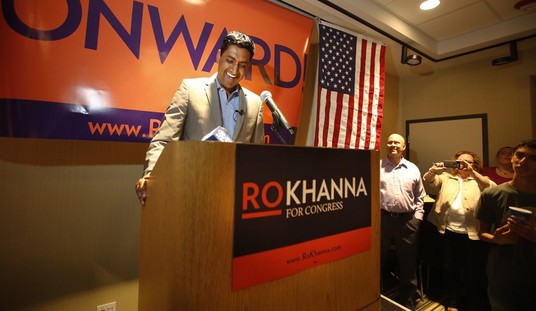“If it’s not broke,” Rep. Alexandria Ocasio-Cortez told an audience about the Veterans Administration, “don’t fix it.” Ocasio-Cortez insists that the VA isn’t broken at all, and that chronic and widespread reports of problems and breakdowns are nothing more than a Republican plot to “shop out care to for-profit healthcare corps.”
In the very next sentence of her tweet, Ocasio-Cortez then acknowledges the massive wait-time issues at the VA and insists that all the single-payer system needs is more cash (via Twitchy):
The GOP participates in a lobbyist-friendly campaign to trash the VA, so we tear it up & shop out vet care to for-profit healthcare corps.
To reduce VA wait times, we must FUND the VA so they can hire+fill the 48,000 vacancies for healthcare providers for our vets. #ProtectTheVA https://t.co/unC7c4zs2n
— Alexandria Ocasio-Cortez (@AOC) April 25, 2019
Like many public systems, GOP want to rip the battery out + say the whole car doesn’t work, so they can sell it for parts.
Fully funding the VA & hiring to fill the *49k vacancies* is a clear path to improving it – not auctioning off our vet care systems to for-profit companies.
— Alexandria Ocasio-Cortez (@AOC) April 25, 2019
Well, which is it? Is it “not broke,” or does it need a lot of cash to fix its problems? Before we get to the cash argument, let’s address the second point. Why are there 49,000 vacancies in a government agency? That number, by the way, is for the overall Department of Veterans Affairs, but 43,000 of them are in the VA, so Ocasio-Cortez isn’t far off the mark. Has the Trump administration ordered the VA not to fill those jobs? Nope, VA Secretary Robert Wilkie testified in February. They’re just having a tough time trying to find people who want to work there:
About 43,000 of the VA vacancies are within the Veterans Health Administration, Dr. Richard Stone, the administration’s executive in charge, told committee members. He said the VA has purchased commercial human resource management software and the agency is now better able to monitor openings within their workforce. …
Lamb asked Wilkie during the hearing whether the White House had asked him not to fill any of the 49,000 vacancies. Wilkie responded no.
“I also know that we’re being told by the workforce, the boots on ground, the nurses, the staff members, that they are shorthanded and it’s affecting their quality of work and their health and physical condition at the end of the work day. The shortages are being felt by the people who are there,” Lamb said.
That’s not due to a relative lack of cash, either. Defenders of the status quo have trotted out the budget excuse for the VA since the wait-time scandal first erupted. Ocasio-Cortez is merely the latest in a long line of either woefully uninformed or willfully ignorant advocates that refuse to acknowledge that Congress has opened up the spigots more every year — and still aren’t getting the improvements that such money should produce, and would produce in any system built for accountability.
I first took a look at the VA’s budget five years ago:
OMB historical data on budget outlays by department are easily available at the White House website, and the spreadsheet tells a very interesting story. Since 9/11, the VA budget has increased by 235%, from FY2001’s $45 billion annual budget to FY2014’s $150.7 billion. On a percentage basis, the only Cabinet agencies that had larger budget increases over that arc have been State (271%) and Homeland Security (245%), the latter of which barely existed at the start of that period. In the Bush era, comparing the final budget with his signature (FY08) to the final Clinton budget (FY01), VA spending rose 88.3% to $84.7 billion. Defense spending rose 104% in the same period.
Barack Obama ran in 2007-8 on failures at the VA, promising more resources and better management. In comparison to that final Bush budget — don’t forget that Obama signed the FY2009 budget in March 2009 with the omnibus spending bill after a Democrat-controlled Congress refused to deal with Bush — VA spending has risen dramatically as well. The annual budget rose 78% in six budget cycles, with double-digit increases in four of the six years — while Defense spending was flat. No other Cabinet agency had a larger budget increase by percentage during Obama’s tenure. The closest was Agriculture (64%), followed by State (59%, which tends to discredit the canard about the Benghazi failure being caused by a lack of resources). Only HHS had a larger annual budget increase in terms of dollars spent, but it amounts to a 37% increase in spending from the FY2008 baseline. The amount of increase in the VA’s budget in the Obama era, $65.9 billion, exceeds the entire VA budget in the FY2004 budget.
What has happened since FY2014? The VA budget has continued its rapid expansion:
- FY 2014 final: $149.6 billion
- FY2015: $159.7 billion
- FY2016: $174.5 billion
- FY2017: $176.5 billion
- FY2018: $177.2 billion
- FY2019 estimate: $197.9 billion
- FY2020 estimate: $210.7 billion
The increase in the VA’s budget between FY2014 and FY2019 is more than its entire FY2001 outlay. In the past five years, VA spending has increased 32%, far outstripping the spending increases in most other government spending.
Now, ask this question: has the VA improved by 32% on any of its metrics over the past five years? Has it successfully cared for 32% more veterans? Improved outcomes by 32%? And for that matter, let’s ask those same questions in context for the whole post-9/11 period, in which the VA budget has grown 340%. Is there any phase of VA operations that have improved even 34% over that period, let alone 340%?
The answer is no, and that drives home the point that funding isn’t the problem. Neither is leadership, at least considered in a vacuum, as the VA has had a number of leaders but still fail to significantly improve operations. The performance issues within the VA relate to the structure of the organization itself — its lack of real accountability and the lack of any competition that would force it to provide such accountability. Single-payer systems become bureaucracies whose highest priority is the survival of the bureaucrats and not the patients or providers stuck within the system. And that’s why the VA has 43,000 open positions, because this job market provides plenty of better environments in which to work.
Ocasio-Cortez motive in ignoring all this is patently obvious. She and other “Democratic Socialists” want to push everyone into a single-payer system. The track record of the VA makes it clear just how bad an idea that is. In order to salvage her talking point, Ocasio-Cortez is willing to play Chip Diller while tossing veterans under the bus. It’s nothing but brute ideology triumphing over reality.
Retired Navy SEAL Rob O’Neill spoke with Fox Business Network’s Trish Regan about the conditions at the VA, which he knows from personal experience. O’Neill shares some of those experiences, and the lack of progress on giving veterans other options. Earlier this month, the Daily Beast reported that three veterans killed themselves in VA facilities within five days, which O’Neill mentions too. Something’s very much “broke” at the VA, and money isn’t fixing it.








Join the conversation as a VIP Member